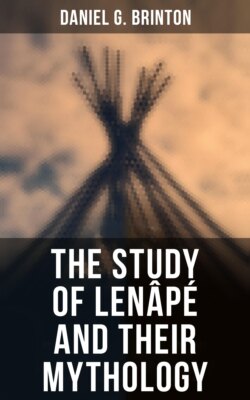Читать книгу The Study of Lenâpé and Their Mythology - Daniel G. Brinton - Страница 6
На сайте Литреса книга снята с продажи.
§ 1. The Algonkin Stock.
ОглавлениеTable of Contents
About the period 1500–1600, those related tribes whom we now know by the name of Algonkins were at the height of their prosperity. They occupied the Atlantic coast from the Savannah river on the south to the strait of Belle Isle on the north. The whole of Newfoundland was in their possession; in Labrador they were neighbors to the Eskimos; their northernmost branch, the Crees, dwelt along the southern shores of Hudson Bay, and followed the streams which flow into it from the west, until they met the Chipeways, closely akin to themselves, who roamed over the water shed of Lake Superior. The Blackfeet carried a remote dialect of their tongue quite to the Rocky Mountains; while the fertile prairies of Illinois and Indiana were the homes of the Miamis. The area of Ohio and Kentucky was very thinly peopled by a few of their roving bands; but east of the Alleghanies, in the valleys of the Delaware, the Potomac and the Hudson, over the barren hills of New England and Nova Scotia, and throughout the swamps and forests of Virginia and the Carolinas, their osier cabins and palisadoed strongholds, their maize fields and workshops of stone implements, were numerously located.
It is needless for my purpose to enumerate the many small tribes which made up this great group. The more prominent were the Micmacs of Nova Scotia, the Abnakis of Maine, the Pequots and Narragansets, in New England, the Mohegans of the Hudson, the Lenape on the Delaware, the Nanticokes around Chesapeake Bay, the Pascataway on the Potomac, and the Powhatans and Shawnees further south; while between the Great Lakes and the Ohio river were the Ottawas, the Illinois, the Pottawatomies, the Kikapoos, Piankishaws, etc.
The dialects of all these were related, and evidently at some distant day had been derived from the same primitive tongue. Which of them had preserved the ancient forms most closely, it may be premature to decide positively, but the tendency of modern studies has been to assign that place to the Cree—the northernmost of all.
We cannot erect a genealogical tree of these dialects. It is not probable that they branched off, one after another, from a common stock. The ancient tribes each took their several ways from a common centre, and formed nuclei for subsequent development. We may, however, group them in such a manner as roughly to indicate their relationship. This I do on the following page:—
Cree,
Old Algonkin,
Montagnais.
Chipeway,
Ottawa,
Pottawattomie,
Miami,
Peoria,
Pea,
Piankishaw,
Kaskaskia,
Menominee,
Sac,
Fox,
Kikapoo.
Sheshatapoosh,
Secoffee,
Micmac,
Melisceet,
Etchemin,
Abnaki.
Mohegan,
Massachusetts,
Shawnee,
Minsi, }
Unami, }
Unalachtigo,}
Nanticoke,
Powhatan,
Pampticoke.
Blackfoot,
Gros Ventre,
Sheyenne.
Granting, as we must, some common geographical centre for these many dialects, the question where this was located becomes an interesting one.
More than one attempt to answer it has been made. Mr. Lewis H. Morgan thought there was evidence to show that the valley of the Columbia river, Oregon, "was the initial point from which the Algonkin stock emigrated to the great lake region and thence to the Atlantic coast."[1] This is in direct conflict with the evidence of language, as the Blackfoot or Satsika is the most corrupt and altered of the Algonkin dialects. Basing his argument on this evidence, Mr. Horatio Hale reaches a conclusion precisely the reverse of that of Morgan. "The course of migration of the Indian tribes," writes Mr. Hale, "has been from the Atlantic coast westward and southward. The traditions of the Algonkins seem to point to Hudson's Bay and the coast of Labrador."[2] This latter view is certainly that which accords best with the testimony of language and of history.
We know that both Chipeways and Crees have been steadily pressing westward since their country was first explored, driving before them the Blackfeet and Dakotas.[3]
The Cree language is built up on a few simple, unchangeable radicals and elementary words, denoting being, relation, energy, etc.; it has extreme regularity of construction, a single negative, is almost wholly verbal and markedly incorporative, has its grammatical elements better defined than its neighbors, and a more consistent phonetic system.[4] For these and similar reasons we are justified in considering it the nearest representative we possess of the pristine Algonkin tongue, and unless strong grounds to the contrary are advanced, it is proper to assume that the purest dialect is found nearest the primeval home of the stock.
